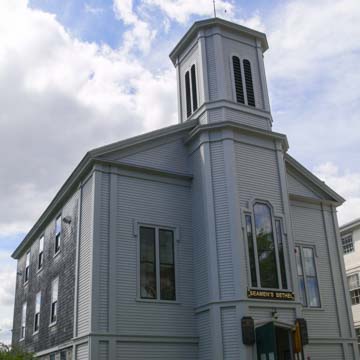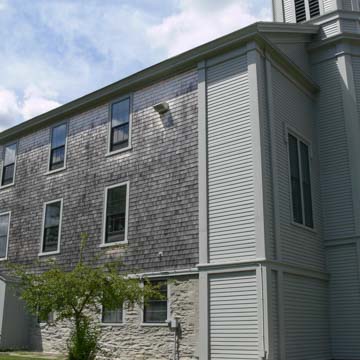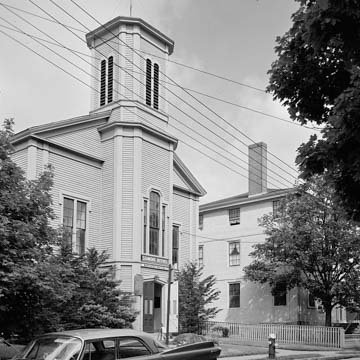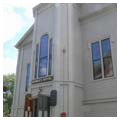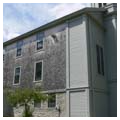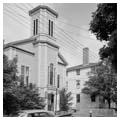Throughout the nineteenth century, the Seamen’s Bethel served the mariners of New Bedford as a nondenominational house of worship and memorialized those who perished at sea. The New Bedford Port Society for the Moral Improvement of Seamen, a group of prominent, mostly Quaker, citizens, built the large house of worship in 1831 when New Bedford’s whaling industry, which served as the foundation of the town’s economy and culture for nearly a century, was at its peak. Sited at the top of Johnnycake Hill in the historic city center, the Seamen’s Bethel reflects both the centrality of individual seamen to the city’s livelihood as well as the perils those men faced on their long journeys. Furthermore, the Seamen’s Bethel has become an important part of the history of literature in the United States because it served as the inspiration for the Whalemen’s Chapel that figures prominently in Herman Melville’s novel, Moby Dick.
New Bedford has always had an intimate relationship with the sea. Unlike most other settlements in the region, which had agricultural bases, New Bedford’s harbor formed the foundation for its first, and relatively late (for Massachusetts), substantial settlement in 1764. By the turn of the nineteenth century, whale fishery served as New Bedford’s dominant, even sole, industry. By 1820, the city had overtaken Nantucket as the leading whaling port, and by 1832 New Bedford had 129 ships engaged in whaling. The whale oil and spermaceti procured during long, arduous transoceanic voyages provided lighting fuel and lubrication for the machines of the growing Industrial Revolution.
The whaling industry endowed New Bedford’s Quaker founders with vast wealth and shaped the built environment of the growing city center next to the harbor. Shipbuilders, mechanics, spermaceti candle works, and other businesses associated with whaling moved into the rapidly growing city. As diverse peoples from around the British colonies and the world flocked to the city to partake in its promise of wealth and adventure, houses of worship materialized to cater to differing Christian sects. By 1830, the city contained Congregationalist, Methodist, and Roman Catholic churches.
Quakers, the first European settlers in the area that became New Bedford, largely controlled the whaling industry. Though this open-minded and tolerant religious group had its own meetinghouses, by 1830 its members began to express concern for the spiritual wellbeing of the many mariners who lived in the town temporarily and frequented the saloons, brothels, and gambling dens that had sprung up around the waterfront. This situation elicited a paternalistic anxiety among Quaker leaders and, in order to alleviate this depravity, the Port Society determined to build a house of worship that welcomed all, regardless of belief or affiliation.
The resulting Seamen’s Bethel (which means “house of God”) is a large, two-story, wood-framed building designed by local builders Edward Thomas Patrick and Dudley Davenport. While certainly impressive, this austere Greek Revival building bears little ornamentation, in keeping with the Quakers’ belief in frugality and restraint. The gabled front elevation has a narrow, five-sided projecting center bay capped by an octagonal tower. Entrance to the building is through a double door in the projecting bay, above which is a modified Palladian window. The flanking bays have paired rectangular windows on the second floor and the front facade’s windows and entrance door all have very simple, but heavy, hood molding. Gray-painted clapboards cover the front of the building, and wood shingles sheath the other three sides.
The building’s interior consists of spaces for worship and for education. The ground floor had a main room in which the Port Society provided classes and other multipurpose rooms. The sanctuary occupies a two-story auditorium space lit by two rows of double-hung sash windows. Two galleries are supported by Doric columns and an organ is located at the rear.
Herman Melville attended services at the Seamen’s Bethel before the whaling journey he undertook in 1840. Three chapters of Melville’s Moby Dick take place in the semi-fictional Whalemen’s Chapel, including a fiery and ominous sermon by Father Mapple, a character partly based on Father Enoch Mudge, whom Melville heard preach in the Seamen’s Bethel. In the Whalemen’s Chapel, Ishmael reflects on the mortal dangers of the whaling industry, the nature of the spiritual self, and the role of faith. The Port Society hoped to provide a space for this kind of meditation in the Seamen’s Bethel.
Melville mentions two distinctive features of the Whalemen’s Chapel’s interior: marble memorial tablets on the sanctuary’s walls and a pulpit shaped like a ship’s prow. In the Seamen’s Bethel, memorial plaques line the walls and recount the names and stories of just some of the many mariners who shipped from New Bedford and died at sea. However, the prow-shaped pulpit was a product of Melville’s imagination. After a popular 1956 film adaptation, though, tourists to the site were disappointed to find an ordinary pulpit. To quell this dissatisfaction, the Port Society installed a prow-shaped pulpit in 1960.
Today, the Seamen’s Bethel is open to the public and hosts weddings, christenings, and memorial services. The Port Society still operates and cares for the building, which, despite an 1866 fire, remains remarkably intact. It continues to be a popular destination within the New Bedford Whaling National Historical Park, which is a public-private partnership that preserves and interprets the historic city center. The Seamen’s Bethel endures as a significant space memorializing the lives of mariners past and present and the risks involved in their profession.
References
Haley, Peter. “Form B – Building: Seamen’s Bethel, New Bedford, MA (NBE.153).” Boston: Massachusetts Historical Commission, January 2012.
Melville, Herman, Hayford, Harrison, and Hershel Parker. Moby Dick. 2nd ed. New York: Norton, 2002.





